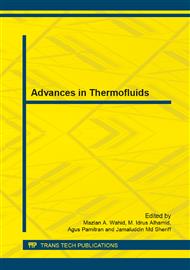p.40
p.47
p.52
p.58
p.63
p.71
p.76
p.83
p.91
The Influence of Temperature in Wear Resistance Characteristic of Palm Fatty Acid Distillate
Abstract:
Palm fatty acid distillate (PFAD) has potential to be used as a lubricant. PFAD is a by-product from palm oil refinery, and it is classified as non-edible oil. However, vegetable oil has poor thermal performance and high oxidation rate. In this paper, the tribological performance of PFAD in different working temperature was investigated by using four-ball tribotester. Tests were conducted at temperatures 50oC, 75oC, 100oC and 125oC, under a normal load of 40 kg for one (1) hour. The rotational speed was set at 1200rpm. Similar tests were conducted using industrial hydraulic oil as a comparison lubricant. Analyses were focused on the coefficient of friction (CoF), wear scar diameter (WSD) and worn surface observation. Results show that coefficient of friction and wear were increased with the increment of temperature. However, palm fatty acid distillate show a better performance in term of friction reduction compared to industrial hydraulic oil.
Info:
Periodical:
Pages:
63-67
Citation:
Online since:
August 2013
Price:
Сopyright:
© 2013 Trans Tech Publications Ltd. All Rights Reserved
Share:
Citation:


